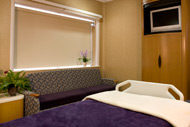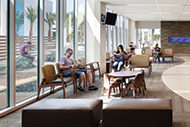 A timeless design will always have a place and a purpose. In defining timeless design, our responses may focus more on the aesthetics of an object than on the purpose or function of it. But when it comes to furnishings for health care environments, a timeless design has everything to do with flexibility and keeping up with change. Or, in this case, keeping up with time.
A timeless design will always have a place and a purpose. In defining timeless design, our responses may focus more on the aesthetics of an object than on the purpose or function of it. But when it comes to furnishings for health care environments, a timeless design has everything to do with flexibility and keeping up with change. Or, in this case, keeping up with time.
Keeping up with time and with change is a challenge for health care facility managers. Selecting furnishings that allow for—and even improve—efficiency in how staff goes about their work, whether it be caregiving or cleaning, is also a challenge. Managing budgets and purchasing within a facility is yet another challenge. Furnishings that retain value and functionality remain relevant and contemporary. Timeless designs can improve productivity, efficiency, and offer an impressive return on investment.
Based on the experiences of several health care organizations, modular, flexible furnishings keep their facilities efficient and fresh and keep the myriad of changes happening within them manageable and cost effective. When they become part of a standards program, the payoff and results over time are compelling.
The following installations demonstrate the benefits of a successful furnishings program.
Consistent aesthetic
Community Hospital of the Monterey Peninsula was built in the 1970s. It established a furniture standards program at that time that is still followed today.
Those standards remain fresh and progressive, and they enable the hospital to respond to change gracefully and cost effectively. The hospital has maintained a consistent look over the decades despite major expansion projects, reinforcing its culture and style and remaining familiar to patients and guests over time — a powerful brand reinforcement.
"Hospitals are often a monument to the architect, not to the owner," says Frank Vitale, consultant and former facilities director at Community Hospital. "Hospitals make a mistake when they generate a 'new' and an 'old' with very little continuity between them. At Community hospital the buildings are seamless, and the standards are timeless."
Inventory management
The Lake Forest (Ill.) Hospital has worked tirelessly to build a standards program, in large part because of the nightmare of managing inventory coming from dozen of product lines, paint colors, and multiple manufacturers.
"Without standards, we built up an inventory of obsolete product," says Director of Facilities Roger Wojtowicz. Cost is now improved on many levels. Product is used efficiently, inventory is better managed, and architectural costs are lowered.
Modular products can be rearranged and reconfigured with minimal cost, instead of continually redesigning custom casework, says Wojtowicz. Several years ago, the hospital saved $123,700 in reconfiguration costs by reusing one-third of its existing product rather than buying new.
Adaptive and responsive
"Health care is such a dynamic, complex, process-oriented environment; things are constantly changing, which is why flexibility is so important," emphatically states Ron Rohlfing, vice president of operations at Cincinnati, Ohio's West Chester Hospital and a Lean/six-sigma black belt.
 |
| Mobile, durable and reconfigurable Co/Struc lockers and carts offer West Chester Hospital a flexible storage system. |
Lean initiatives and continuous improvement make a case for furnishings that are flexible, mobile, and adaptive. In order to enable changes that improve processes, patient/staff experiences, and budgets, interiors and the furnishings within them need to support improvement.
"As people work, they find different ways of doing things, maybe one way works better than another, so you have to be able to change things around at any point in the process," says Herman Miller Healthcare's Mark Heekin.
The ability to change and remain flexible also makes the functionality of furnishings timeless. A case in point is the Brooke Army Medical Center (BAMC), a 30-million-square-foot facility in San Antonio. It has 224 inpatient beds, with the capability of expanding to 450 beds in response to catastrophic events. The emergency room receives 4,000 visits a month. It houses the military's only Level 1 Trauma Center, burn center and one of two amputee centers.
With such volume levels and complexities, a standards program that defined flexibility was essential. Since its construction in 1996, reconfiguration throughout the facility has been constant. Designing for flexibility has long-term benefits: Hundreds of 10-foot by 10-foot exam rooms can transition from exam room to office within hours because they were planned, constructed, and furnished to do so.
Modular furnishings provide the flexibility to adapt and target specific functions within each unit. Staff can easily add, remove or reconfigure product components themselves. Stocking and restocking can be done efficiently.
 |
| The Ethospace system's timeless design and total modularity create a welcoming registration station at Providence Park Hospital. |
Finally, flexible products can support the staff to help them be more productive and comfortable at work. Or if equipment or supply sizes change, the shelves or storage components can be adapted. Sally Levell, director of nursing at the Mackinac Straits Hospital in St. Ignace, Mich., observes, "Something might seem like a good idea at the planning stage, but you don't really know how it's going to work until you live with it awhile. We ended up moving things around a little bit, which we never could have done with built-ins." Laura Anderson, also with Mackinac Straits, agrees. "Just the ability to change a small desktop to a larger one or adjust shelving is so convenient."
Improved cost efficiencies
Rick Abbott, director of corporate real estate and construction for the St. John's Health System, is sold on the cost advantages of modular systems products. First cost dollars for millwork versus systems products can favor millwork—but not always, and often the differences are minimal. If an organization wants flexibility, says Abbott, "any premium with systems furniture is neutralized over time." In fact, the costs for furnishing St. John's Providence Park Hospital came in with systems solutions at a lower cost.
 |
| Modular systems give staff at Mackinac Straits Hospital an organized work area that can be easily changed when needed. |
Laura Agabashian works for a Herman Miller dealer who helped with the construction of a small rural hospital in Michigan's Upper Peninsula. Mackinac Straits Hospital selected a modular systems approach, though they also had initial doubts about cost. But what the hospital has learned: "You get the added benefit of flexibility and adaptability, which proves to be so economical later," says Agabashian.
Between a standards program and modular furnishings, Community Hospital of Monterey Peninsula has seen an ROI over its 40 years of operation that is off the charts. But it doesn't start with trying to save a dollar here or a dollar there.
From the beginning, the hospital "Looked at life-cycle costs and bought first-rate product, knowing it would last longer than cheaper products," says Frederick Bensch, director of facilities planning. Ongoing management of a modular solution has also contributed to the hospital's return on investment.
"We manage around 30 to 40 moves a month with one employee and one designer," says LaMar Associations' Lynn LaMar. She is principal of the company Community Hospital contracts with to manage the warehouse, moves, and installs. The hospital has saved 25 to 50 percent on labor costs with this arrangement, but also important, operate with a furniture solution that helps to streamline and adapt quickly and cost effectively.
Furnishing health care interiors with products that are flexible and can adapt to change is a smart business decision.
Kerrie Cardon, R.N., AIA, ACHA, is knowledge integrator and health care consultant at Herman Miller Inc., Zeeland, Mich. She can be reached at Kerrie_Cardon@hermanmiller.com.




